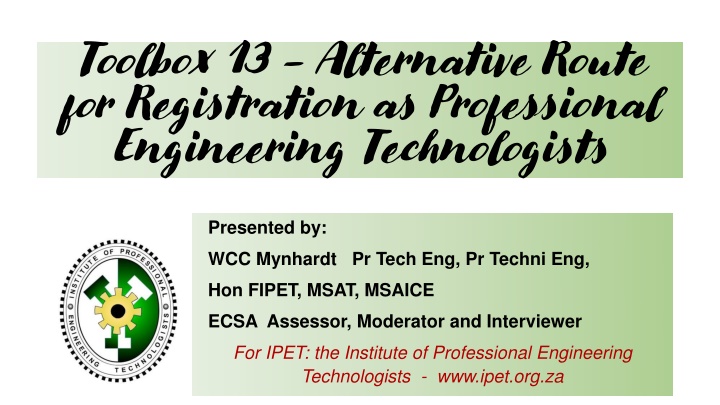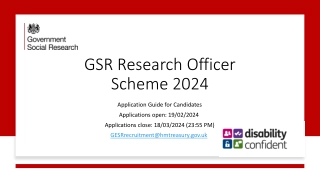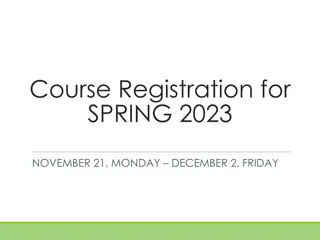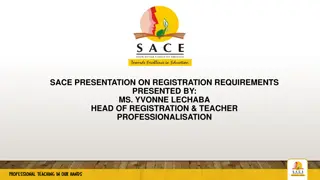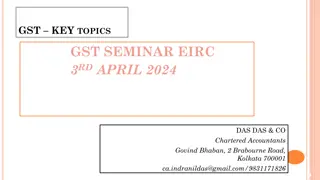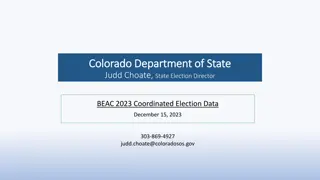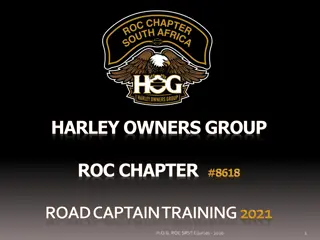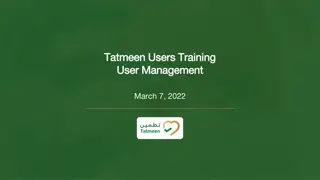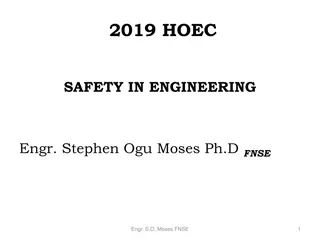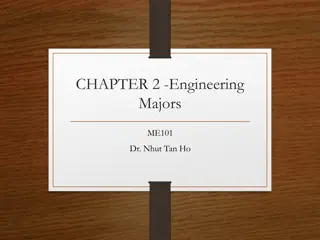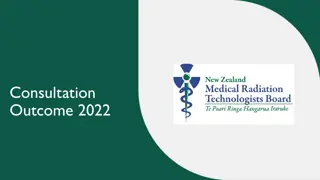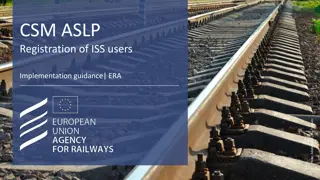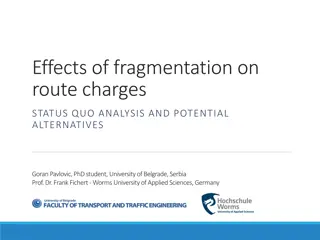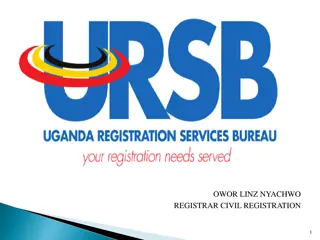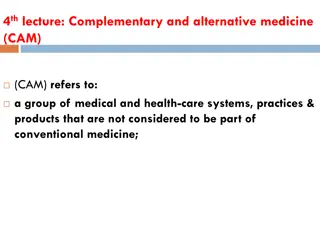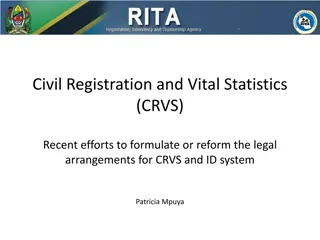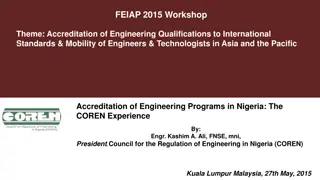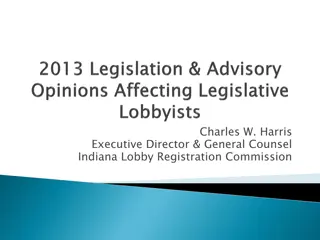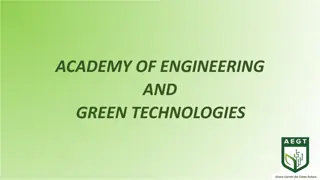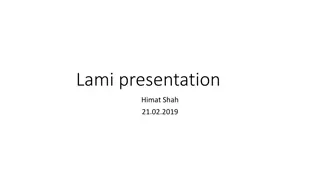Alternative Route for Professional Engineering Technologists Registration
This presentation discusses an alternative route for registration as a Professional Engineering Technologist at ECSA. It covers the forms required, the difference from regular registration, and key outcomes to understand. The presentation aims to guide prospective applicants through the registration process, emphasizing the importance of meeting ECSA's standards for successful registration.
Download Presentation

Please find below an Image/Link to download the presentation.
The content on the website is provided AS IS for your information and personal use only. It may not be sold, licensed, or shared on other websites without obtaining consent from the author.If you encounter any issues during the download, it is possible that the publisher has removed the file from their server.
You are allowed to download the files provided on this website for personal or commercial use, subject to the condition that they are used lawfully. All files are the property of their respective owners.
The content on the website is provided AS IS for your information and personal use only. It may not be sold, licensed, or shared on other websites without obtaining consent from the author.
E N D
Presentation Transcript
Toolbox 13 - Alternative Route for Registration as Professional Engineering Technologists Presented by: WCC Mynhardt Pr Tech Eng, Pr Techni Eng, Hon FIPET, MSAT, MSAICE ECSA Assessor, Moderator and Interviewer For IPET: the Institute of Professional Engineering Technologists - www.ipet.org.za
Disclaimer This presentation and discussion have been made available in good faith for the use of prospective applicants for Professional Registration at the Engineering Council of South Africa (ECSA). We have tried to make the material as accurate and reliable as possible. We do not guarantee registration on the strength of following the directives and guidelines discussed in this webinar, and the material supplied. The ECSA registration process is a peer-review system, and your registration is wholly dependent on you having met all the outcomes, and on your ability to describe this to the assessors in a manner satisfactory to them. Applicants make use of this material at their own risk and we take no responsibility for the outcome of any application for ECSA Registration based on the content of this presentation.
Introduction Today we are discussing the alternative route for registration as a Professional Engineering Technologist at ECSA. What forms are required to be completed The difference between the regular registration against the alternative route. Explaining the five outcomes
Where do I find information about the outcomes? The following ECSA Policy documents are to be studied to ensure you understand the requirements for the eleven outcomes. R-02-STA-PE/PT/PCE/PN, Competency Standard for Registration in Professional Categories as PE/PT/PCE/PN, Revision 1: 20 August 2020 referred to as R-02. R-08-PT: Guide to the Competency Standard for Registration as a Professional Engineering Technologist referred to as R-08.. The website link is: https://www.ecsa.co.za/EcsaDocuments/sitepages/ecsa%20documents.aspx
What forms are required for Alternative Route The alternative route the following forms are required: Training and Experience Outline Form B2.1 TEO Educational Development Report Form B18-EDR only outcomes 1 to 5 Engineering Report Form B2.3 ER only outcomes 6 to 11
Form B2.1 TEO This form must be used for an applicant who has at least ten years training and experience after completing the educational requirement and reports a total duration of at least three years at a degree of engineering responsibility E (Performing) in detail TER format .For the remaining periods or groups of related periods the report can be in this TEO format. Consult the Information Sheet (Sheet B2) before completing this report. Training and Experience Outline As part of the Application for Registration as Professional Engineering Technologist Applicant s Name Applicant s Signature Period No: Start date: End date: No of weeks: Position(s) held: Employer s and Supervisor Name and Address: ECSA Registration No. (If not registered, qualify): If yes, provide number of CU: Date: Did you train under a Commitment and Undertaking (CU)? Yes No No: Discipline of Engineering: (Aeronautical, Agricultural, Chemical, Civil, Electrical, Industrial, Mechanical, Metallurgical, Mining) Discipline Specific Field: (e.g. Power Transmission, Electronic Communication, Transportation, Structures, Automotive, Roads, etc) Organogram identifying yourself, your supervisor and persons supervised*. Please do not colour in blocks.
Form B18-EDR EDUCATIONAL DEVELOPMENT REPORT A INSTRUCTIONS 1. Applicants not in possession of an ECSA accredited B Tech (Eng) should complete this work based (experience) learning report. WRITE A REPORT IN ABOUT 100 WORDS ON EACH CRITERION LISTED. 2. Reports must include reference to broadly-defined practical examples in the work place demonstrating how the competencies were satisfied, and is not restricted to a single task or project. (Additional supporting evidence may be attached, if necessary limited to two A4 pages). 3. This information can be provided from education or experience, or a combination of both. 4. The applicant must sign the completed report and also obtain a signature from his/her supervisor. 5. The applicant may be invited to an interview to expand and/or confirm this report. Broadly-defined engineering problems have the following characteristics: a) require coherent and detailed engineering knowledge underpinning the applicable technology area; and one or more of: b) are ill-posed, under- or over specified, requiring identification and interpretation into the technology area; c) encompass systems within complex engineering systems; d) belong to families of problems which are solved in well-accepted but innovative ways; and one or more of: e) can be solved by structured analysis techniques; f) may be partially outside standards and codes; must provide justification to operate outside; g) require information from practice area and sources interfacing with practice area that is complex and incomplete; h) involves a variety of issues which may impose conflicting constraints: technical, engineering and interested or affected parties. APPLICANT S PERSONAL DETAILS Name: B. Technical Qualifications:
Form B2.3 ER Engineering Report Use this form to submit a report in about 100 words per criterion under Outcomes 1 to 11 below on recent engineering work to which you have made a significant contribution. The report may cover conceptualisation, design and analysis, specification, tendering and adjudication, manufacturing, project and construction management, commissioning, maintenance, measurement and testing or planning at a broadly-defined level. Please cross-refer the item reported upon to the relevant evidence in the Training and Experience Report (B2.1 TER) or Training and Experience Outline (B2.1 TEO). Provide sample relevant calculations and drawings as an addendum. Use Appendix A of the Discipline Specific Training Guide R-05-PT to assist in the interpretation of the criteria Name of Applicant: Consult the Information Sheet (Sheet B2) before completing this report. Area of Employment: (<15 words) Dates Undertaken: Engineering brief and objective:(<30 words) Environment:(Industry; Laboratory; Theory; Simulation) (<15 words) Short Summary: (State engineering problems; solutions in < 30 words) Budgets <10 words)
Outcome no. 1 Exit level outcome 1 The requirement for this is that you must be able to demonstrate your understanding and the ability to apply the fundamentals of engineering in your area of expertise with the applicable fundamentals of mathematics and natural science. Outcome no.1 has three sub-divisions. Sub-division 1.1 is where you discuss your knowledge of mathematical, natural science and engineering knowledge you used to solve the broadly-defined engineering problem.
Outcome no. 1 (Cont.) Sub-division 1.2 consists of the discussion of how you solved the broadly-define engineering problem through analysing and designing a solution. You must be able to motivate your solution using engineering materials, systems or processes. Sub-division 1.3 you describe procedures you applied in dealing with uncertainty and risks identified in your own theoretical limitations and where you used a specialist to do the work. To summarise here your demonstrate your knowledge of the theories and principles you utilized on a broadly-defined level.
Exit Level Outcome 1. The applicant displays understanding of and the ability to apply the fundamentals of engineering in a selected sub-discipline together with the underpinning fundamentals of mathematics and natural science. Item Development Report Criteria State what mix of mathematical, natural science and engineering knowledge you applied in the solu-tion of the broadly-defined engineering problem. State which theories and principles were used. 1.1 Describe how you analysed and modelled the engineering materials, components, systems or processes used and provide the motivation for the specific selection. 1.2 1.3 Describe the procedures applied for dealing with uncertainty and risk applicable to your own theoretical limitations and the use of specialists to do the work.
Outcome no. 2 Exit level outcome 2 The requirement for this outcome is where you display proficiency in your engineering field of expertise. This outcome has three sub-divisions. Sub-division 2.1 you describe how you analysed and defined the identified problem with your engineering knowledge and your skill to solve the problem. Sub-division 2.2 you must describe how you generated various solutions to the problem and how the best solution was identified.
Outcome no. 2 (Cont.) Sub-division 2.3 is where you demonstrate how you selected, formulated and presented your chosen solution. In summary you must describe how you solved and identified the best solution with proof of your selection for the broadly-defined engineering problem identified in outcome no. 1.
Exit Level Outcome 2. The applicant displays proficiency in engineering specialist fields of a selected engineering sub-discipline at the exit level. Item Development Report Criteria Describe how you analysed and defined a problem and identified the engineering knowledge and skills required for solving the problem. 2.1 2.2 Describe how you generated possible solutions to the problem and how they were modelled, analysed and prioritised. State how you selected, formulated and presented the preferred solution. 2.3
Outcome no. 3 Exit level outcome 3 This outcome requires you to be able to demonstrate your competency in the use of engineering tools and Information Technology (IT). Outcome no.3 has two sub-divisions. Sub-division 3.1 is where you discuss your ability to use acceptable methods, skills or tools which can include computer programs to solve a broadly defined engineering problem
Outcome no. 3 (Cont.) Sub-division 3.2 is where you indicate how you applied the method, skill or tool to achieve the required result and how you confirmed the results as correct. To summarise here you demonstrate your competency for the use of various methods inclusive of your skill with the various computer programs and tools to solve broadly-defined engineering activity and how you confirmed your results as correct.
Exit Level Outcome 3. The applicant displays proficiency in the use of engineering tools and IT support appropriate to the sub-discipline. Item Criteria Development Report 3.1 Describe how you assess the method, skill or tool (including com-puter applications) for applicability to solving problems. Describe how you applied the method, skill or tool correctly to achieve the required result, and how this tested against the required results. 3.2
Outcome no. 4 Exit level outcome 4 Here you display your design competency in the properly structured approach of your project work for a broadly-defined engineering problem. This outcome has four sub-divisions. Sub-division 4.1 you describe how you developed the design problem and what process was followed for the development of the design problem Sub-division 4.2 you must describe what needs for the user, legislation, standards and resources were captured and evaluated.
Outcome no. 4 (Cont.) In sub-division 4.3 you demonstrate your ability to perform a design task, selection of a preferred solution from your various alternatives taking into account the assumptions and limits. In sub-division 4.4 you describe how you evaluated your selected design in relation to impacts and benefits and how this information was communicated in your engineering report. In summary you must demonstrate your design competency in a broadly-defined engineering problem.
Exit Level Outcome 4.The applicant demonstrates design proficiency through substantial project work. The design problem meets the requirements of a broadly-defined engineering problem and the design approach is properly structured. Item Criteria Development Report Describe how you formulated the design problem and how the design process was managed. 4.1 4.2 Describe how user needs, legis-lation, standards and resources were acquired and evaluated. 4.3 Describe how you performed the design task, selecting a preferred solution out of alternatives, subject to relevant premises, assumptions and constraints. 4.4 Describe how the selected design was evaluated in terms of impact and benefits and how this information was communicated in an engineering report.
Outcome no. 5 Exit level outcome 5 The requirement for this outcome is to display your competency in the methodology in experimental or investigative and information handling. This outcome has four sub-divisions. Sub-division 5.1 you describe how you planned your investigation and what information did you use Sub-division 5.2 you describe the methodology you used to do the analysis and what equipment and/or software was selected and used.
Outcome no. 5 (Cont.) Sub-division 5.3 here you demonstrate your ability from data available how you extracted the information, analyzed this information critically and how the conclusions were reached based on your analysing of the information. Sub-division 5.4 Here you describe the purpose, process and outcomes of the investigation are recorded in an engineering report. In summary you must display your competency in collecting, analysing, using this information to form your basis of the conclusions to be recorded in an engineering report.
Exit Level Outcome 5. The applicant displays proficiency in experimental or investigative and information handling methodology Item Criteria Development Report 5.1 Describe the plan you devised to perform the investigation stating what information was used. 5.2 Describe the methodology you used to perform the analysis stating how the equipment and/or software was selected and used. 5.3 From the data available, describe how information was derived, critically analysed and interpreted to reach conclusions. 5.4 Describe how the purpose, process and outcomes of the investigation are recorded in an engineering report.
Conclusion Today we briefly discussed the exit outcomes 1,2, 3,4 and 5 for the alternative route for registration as a Technologist at ECSA. The five outcomes for the alternative route which are 1,2,3,,4 and 5 are to be completed on Form B18-EDR. The remainder outcomes 6,7,8,9,10 and 11 are to be competed on R-03-ER-PT.
Acknowledgement The presentation is based on the Engineering Council of South Africa (ECSA) Documents: R-02-STA-PE/PT/PCE/PN , Competency Standard for registration in Professional Categories as PE/PT/PCE/PN, Revision 1: 20 August 2020 (Table no.7) Technologist Application Form
The End Thank you Any Questions?? For previous presentations go to https://professionalcpd.co.za
IPET SERVICES & GROUPS *Follow the links to join Whatsapp logo Images, Stock Photos Vectors | Shutterstock "IPET Professional Registration Advice" ECSA registration advice. (free sessions) https://chat.whatsapp.com/KYHboJqxzXmlSgqYl0TCKg1 (Updated 7/09/22) Whatsapp logo Images, Stock Photos Vectors | Shutterstock IPET Job portal for free engineering job adverts https://chat.whatsapp.com/DCPIhQDZPyRAFD3HeJHDKd (Updated) IPET Video Tutorials on Professional Registration & CPD https://professionalcpd.co.za IPET Website and Phone www.ipet.org.za 073 336 2471
Disclaimer This presentation and discussion have been made available in good faith for the use of prospective applicants for Professional Registration at the Engineering Council of South Africa (ECSA). We have tried to make the material as accurate and reliable as possible. We do not guarantee registration on the strength of following the directives and guidelines discussed in this webinar, and the material supplied. The ECSA registration process is a peer-review system, and your registration is wholly dependent on you having met all the outcomes, and on your ability to describe this to the assessors in a manner satisfactory to them. Applicants make use of this material at their own risk and we take no responsibility for the outcome of any application for ECSA Registration based on the content of this presentation.
